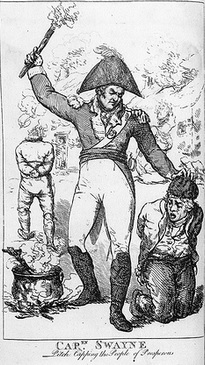Pitchcapping
Pitchcapping was a form of torture used by the British Army during the Irish Rebellion of 1798. This brutal practice involved pouring hot pitch into a conical paper cap which was then placed on the head of the detainee. As the pitch cooled and hardened, it inflicted severe burns and adhered to the skin and hair, causing excruciating pain when removed. Pitchcapping was one of several punitive measures employed to suppress the rebellion and intimidate the Irish population into submission.
History[edit | edit source]
The Irish Rebellion of 1798 was a major uprising against British rule in Ireland, seeking to establish an independent Irish republic. It was led by the United Irishmen, a revolutionary group inspired by the American Revolution and the French Revolution. In response to the insurrection, the British government deployed military forces to Ireland, initiating a campaign marked by extreme violence and repression.
Pitchcapping was not an officially sanctioned method of punishment but was widely reported to have been used by British forces as a means of terrorizing and punishing suspected rebels and their sympathizers. The practice was part of a broader strategy of counter-insurgency that included flogging, half-hanging, and the destruction of property.
Procedure[edit | edit source]
The procedure of pitchcapping involved several steps. First, a cap made of paper or similar material was fashioned into a conical shape. Hot pitch, a tar-like substance, was then poured into the cap. While still hot and liquid, the cap was placed onto the head of the bound victim. As the pitch cooled, it solidified, adhering to the scalp, skin, and hair. The removal of the cap, often forcibly, would tear away skin and hair, leading to severe injuries and, in some cases, permanent disfigurement.
Impact[edit | edit source]
The use of pitchcapping and other forms of torture during the Irish Rebellion of 1798 contributed to widespread fear and resentment among the Irish population. These acts of brutality were intended to crush the rebellion and deter future insurrections but also fueled long-standing grievances against British rule in Ireland. The legacy of such practices has been a lasting source of anger and sorrow, remembered in Irish history as emblematic of the cruelty of British repression.
Contemporary Accounts[edit | edit source]
Contemporary accounts of pitchcapping and other atrocities committed during the rebellion were recorded in letters, diaries, and reports. Some British officers and officials expressed discomfort or opposition to the use of such measures, while others defended them as necessary for maintaining order and quelling the rebellion. The accounts of victims and witnesses, preserved in oral histories and written testimonies, offer harrowing details of the suffering endured by those subjected to pitchcapping and other forms of punishment.
Legacy[edit | edit source]
The practice of pitchcapping, though largely confined to the period of the Irish Rebellion of 1798, has come to symbolize the brutality of British military tactics in Ireland and the extreme measures taken to suppress dissent. It is remembered in Irish history and culture as a symbol of oppression and the struggle for independence. The memory of pitchcapping and the broader context of British-Irish relations continue to influence perceptions and discussions of historical injustices and the process of reconciliation.
Search WikiMD
Ad.Tired of being Overweight? Try W8MD's physician weight loss program.
Semaglutide (Ozempic / Wegovy and Tirzepatide (Mounjaro / Zepbound) available.
Advertise on WikiMD
|
WikiMD's Wellness Encyclopedia |
| Let Food Be Thy Medicine Medicine Thy Food - Hippocrates |
Translate this page: - East Asian
中文,
日本,
한국어,
South Asian
हिन्दी,
தமிழ்,
తెలుగు,
Urdu,
ಕನ್ನಡ,
Southeast Asian
Indonesian,
Vietnamese,
Thai,
မြန်မာဘာသာ,
বাংলা
European
español,
Deutsch,
français,
Greek,
português do Brasil,
polski,
română,
русский,
Nederlands,
norsk,
svenska,
suomi,
Italian
Middle Eastern & African
عربى,
Turkish,
Persian,
Hebrew,
Afrikaans,
isiZulu,
Kiswahili,
Other
Bulgarian,
Hungarian,
Czech,
Swedish,
മലയാളം,
मराठी,
ਪੰਜਾਬੀ,
ગુજરાતી,
Portuguese,
Ukrainian
Medical Disclaimer: WikiMD is not a substitute for professional medical advice. The information on WikiMD is provided as an information resource only, may be incorrect, outdated or misleading, and is not to be used or relied on for any diagnostic or treatment purposes. Please consult your health care provider before making any healthcare decisions or for guidance about a specific medical condition. WikiMD expressly disclaims responsibility, and shall have no liability, for any damages, loss, injury, or liability whatsoever suffered as a result of your reliance on the information contained in this site. By visiting this site you agree to the foregoing terms and conditions, which may from time to time be changed or supplemented by WikiMD. If you do not agree to the foregoing terms and conditions, you should not enter or use this site. See full disclaimer.
Credits:Most images are courtesy of Wikimedia commons, and templates Wikipedia, licensed under CC BY SA or similar.
Contributors: Prab R. Tumpati, MD

